The 5G telemedicine platform market is valued at USD 3,518.1 million in 2025 and is forecasted to reach USD 18,257.4 million by 2035, reflecting a CAGR of 17.9%. This steep upward trajectory signals a rapidly expanding market driven by the convergence of telemedicine adoption and next-generation 5G connectivity. The year-over-year progression, starting with USD 4,147.8 million in 2026 and USD 4,890.2 million in 2027, highlights robust early momentum.
The acceleration in value during the initial phase highlights the increasing role of teleconsultations, remote diagnostics, and AI-powered healthcare services leveraging 5G’s low latency and high bandwidth capabilities.
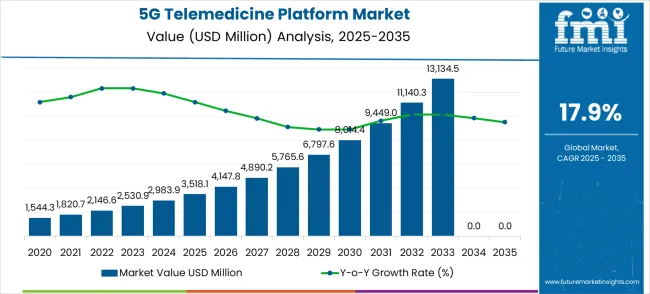
The long-term growth trend clearly indicates consistent expansion across the decade, with the market nearly quintupling in size by 2035. By 2030, the market value surpasses USD 8,014.4 million, signaling mid-phase momentum where adoption becomes mainstream across hospitals, specialty clinics, and home-based care. This segment of growth aligns with the scaling of 5G-enabled healthcare infrastructure and policy-driven investments in digital health. Unlike stagnating or cyclical markets, the data trend reveals uninterrupted expansion, with no signs of plateauing. The pace of adoption is further magnified by the growing role of tele-ICU systems, wearable patient monitoring, and real-time surgical guidance, all benefiting from reliable connectivity.
| Metric | Value |
|---|---|
| Market Value (2025) | USD 3,518.1 million |
| Market Forecast Value (2035) | USD 18,257.4 million |
| Market Forecast CAGR | 17.9% |
The CAGR of 17.9% across 2025 to 2035 quantifies this expansion as one of the highest in healthcare technology domains. Annual increments illustrate compounding growth, where the difference between early and late-phase value additions is striking. For example, the increase from 2025 to 2026 is approximately USD 629.7 million, while the jump from 2034 to 2035 exceeds USD 2,771.9 million. This widening annual contribution highlights the compounding effect of exponential growth, with later years delivering outsized impacts compared to the beginning. Such a pattern is characteristic of high-tech adoption curves where innovation drives long-term scalability.
Trendline visualization would most appropriately follow an exponential model rather than linear or polynomial. The nearly parabolic curve from USD 3,518.1 million to USD 18,257.4 million reflects how growth compounds over time rather than progressing at a fixed rate. Linear models would understate future potential, while polynomial models may not capture the sustained acceleration. Exponential visualization best conveys the market’s trajectory, reflecting increasing healthcare digitization, demographic shifts toward remote care, and continuous integration of AI-driven platforms. Thus, the market shows a clear long-term growth trend, underpinned by high CAGR and exponential scaling potential.
Market expansion is being supported by the rapid increase in healthcare digitalization worldwide and the corresponding need for high-performance medical communication solutions that provide superior connectivity speed and low-latency capabilities for advanced telemedicine applications. Modern hospitals and healthcare facilities rely on consistent real-time communication and data transmission reliability to ensure optimal patient care including remote consultations, surgical guidance, and emergency medical services. Even minor communication delays can require comprehensive medical protocol adjustments to maintain optimal healthcare delivery standards and patient safety.
The growing complexity of healthcare requirements and increasing demand for remote medical services are driving demand for 5G telemedicine platforms from certified developers with appropriate technological capabilities and clinical expertise. Healthcare providers are increasingly requiring documented performance specifications and reliability standards to maintain medical service quality and patient care efficiency. Industry specifications and healthcare standards are establishing standardized telemedicine procedures that require specialized 5G platform technologies and trained medical communication personnel.
The rising focus on accessible healthcare delivery and medical service optimization across urban and rural healthcare sectors is creating substantial market opportunities for 5G telemedicine platform developers. Advanced healthcare communication systems incorporating real-time medical data transmission enable superior patient care and cost reduction compared to conventional healthcare delivery methods. Industry trends toward aging population demographics and healthcare accessibility demands are further accelerating demand for sophisticated telemedicine systems that require precise 5G platform performance.
The 5G Telemedicine Platform market is entering a new phase of growth, driven by demand for advanced healthcare communication, medical technology expansion, and evolving patient care and accessibility standards. By 2035, these pathways together can unlock USD 4,200-5,300 million in incremental revenue opportunities beyond baseline growth.
Pathway A -- Remote Consultation Leadership (Consultation & Diagnosis Platforms) The remote consultation segment already holds the largest share due to its superior accessibility and effectiveness. Expanding diagnostic optimization, platform innovation, and user experience efficiency can consolidate leadership. Opportunity pool: USD 1,400-1,800 million.
Pathway B -- Core Hospital Infrastructure (In-hospital & Clinical Applications) In-hospital applications account for the largest demand. Growing hospital digitalization, especially in emerging economies, will drive higher adoption of 5G telemedicine platforms for clinical communication management. Opportunity pool: USD 1,100-1,400 million.
Pathway C -- Specialized Medical Expansion (Surgery & Teaching Platforms) Remote surgery and teaching applications represent significant growth potential with increasing medical education needs. Systems optimized for high-precision medical applications can capture substantial growth. Opportunity pool: USD 700-900 million.
Pathway D -- Emerging Market Expansion Asia-Pacific and Latin America present growing demand due to rising healthcare infrastructure. Targeting medical facilities and cost-competitive solutions will accelerate adoption. Opportunity pool: USD 450-600 million.
Pathway E -- Emergency Medical Integration With increasing emergency response requirements, there is an opportunity to promote platforms optimized for critical care applications. Opportunity pool: USD 300-380 million.
Pathway F -- Specialized Applications (Rural Healthcare & Home Monitoring) Systems optimized for rural healthcare delivery, home patient monitoring, and specialized medical applications offer premium positioning for underserved sectors. Opportunity pool: USD 180-240 million.
Pathway G -- Platform Services & Medical Support Recurring revenue from platform maintenance, medical training, and healthcare system integration creates long-term revenue streams. Opportunity pool: USD 120-150 million.
Pathway H -- IoT Integration & Predictive Healthcare Digital health monitoring, predictive medical analytics, and IoT connectivity can elevate 5G telemedicine platforms into "smart healthcare" ecosystem categories. Opportunity pool: USD 80-120 million.
The market is segmented by platform type, application, and region. By platform type, the market is divided into remote consultation and diagnosis platform, remote surgery and teaching platform, real-time monitoring and emergency platform, and others. Based on application, the market is categorized into in-hospital application, inter-hospital collaboration, external extension, and emergency medical treatment. Regionally, the market is divided into North America, Europe, East Asia, South Asia & Pacific, Latin America, and Middle East & Africa.
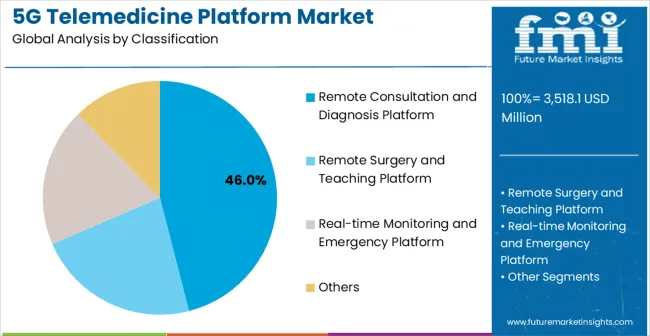
In 2025, the remote consultation and diagnosis platform segment is projected to capture around 46% of the total market share, making it the leading platform type category. This dominance is largely driven by the widespread adoption of virtual healthcare consultations that provide optimal balance between medical accessibility and clinical effectiveness, catering to a wide variety of advanced telemedicine applications. Remote consultation and diagnosis platforms are particularly favored for their ability to deliver superior patient engagement and diagnostic reliability in both hospital and home healthcare installations, ensuring medical accessibility and service quality requirements. Healthcare providers, medical specialists, telemedicine services, and patient care applications increasingly prefer this configuration, as it meets demanding medical communication requirements without imposing excessive infrastructure constraints or operational complexity.
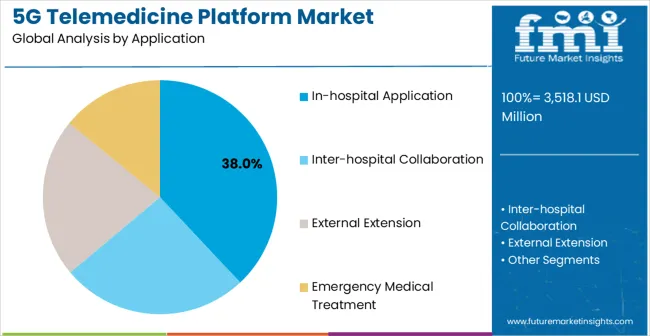
The in-hospital application segment is expected to represent 38% of 5G telemedicine platform demand in 2025, highlighting its position as the most significant application sector. This dominance stems from the critical communication requirements of modern hospital environments, where real-time medical data transmission and clinical coordination are essential to patient care performance and healthcare service delivery. Hospital facilities often feature extensive medical communication networks that demand specialized 5G telemedicine platforms throughout complex healthcare architectures, requiring reliable and high-performance medical communication solutions. 5G telemedicine platforms are particularly well-suited to these environments due to their ability to provide consistent clinical communication performance and operational reliability, even during intensive medical procedures and varying patient loads. As healthcare services expand globally and emphasize improved quality standards, the demand for 5G telemedicine platforms continues to rise.
The segment also benefits from heightened healthcare efficiency requirements within the medical industry, where administrators are increasingly prioritizing clinical communication performance and system reliability as essential operational measures.
The 5G Telemedicine Platform market is advancing rapidly due to increasing healthcare technology adoption and growing recognition of remote medical service advantages over traditional in-person healthcare delivery in accessibility-focused applications. The market faces challenges including higher implementation costs compared to conventional telemedicine alternatives, need for specialized network infrastructure and technical expertise, and complex integration requirements with existing healthcare systems across different medical environments. Quality optimization efforts and advanced platform technology programs continue to influence development and market adoption patterns.
The growing development of ultra-high-speed medical communication systems and enhanced real-time capabilities is enabling superior healthcare delivery with improved patient outcomes and reduced service delays. Advanced 5G technologies and optimized platform designs provide superior medical communication performance while maintaining clinical workflow requirements. These technologies are particularly valuable for healthcare providers who require reliable medical communication that can support extensive patient care operations with consistent high-quality results.
Modern 5G telemedicine platform developers are incorporating advanced artificial intelligence capabilities and intelligent diagnostic systems that enhance clinical performance and medical effectiveness. Integration of smart medical technologies and optimized healthcare management systems enables superior patient care optimization and comprehensive clinical monitoring capabilities. Advanced AI features support operation in diverse medical environments while meeting various clinical requirements and healthcare specifications.
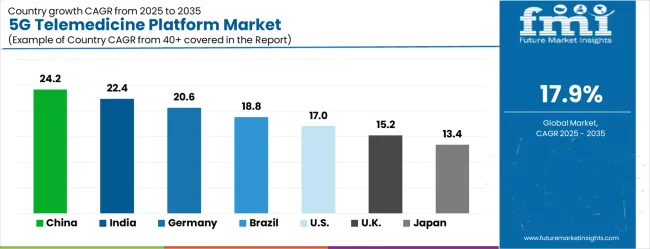
| Country | CAGR (2025-2035) |
|---|---|
| China | 24.2% |
| India | 22.4% |
| Germany | 20.6% |
| Brazil | 18.8% |
| United States | 17.0% |
| United Kingdom | 15.2% |
| Japan | 13.4% |
The market is growing rapidly, with China leading at a 24.2% CAGR through 2035, driven by massive healthcare technology expansion and increasing adoption of advanced medical communication solutions. India follows at 22.4%, supported by rising healthcare infrastructure development and growing awareness of telemedicine benefits. Germany grows strongly at 20.6%, integrating advanced medical technology into its established healthcare system. Brazil records 18.8%, focusing healthcare modernization and digital medical upgrade initiatives. The United States shows solid growth at 17.0%, focusing on hospital technology expansion and healthcare optimization. The United Kingdom demonstrates steady progress at 15.2%, maintaining established medical applications. Japan records 13.4% growth, concentrating on technology advancement and healthcare efficiency optimization.
The report covers an in-depth analysis of 40+ countries; top-performing countries are highlighted below.
China is anticipated to record a CAGR of 24.2% between 2025 and 2035, supported by government-backed digital health initiatives and extensive 5G deployment. The country's massive healthcare sector and expanding hospital facilities are creating enormous demand for sophisticated 5G telemedicine platform solutions. Major healthcare providers are establishing comprehensive digital medical systems to support the increasing requirements of medical institutions and healthcare facilities across metropolitan regions.
Government healthcare digitalization initiatives are supporting establishment of smart hospital facilities and advanced medical complexes, driving demand for high-performance 5G telemedicine platforms throughout major healthcare zones. Healthcare sector modernization programs are facilitating adoption of advanced medical communication technologies that enhance patient care and clinical efficiency standards across healthcare networks.
India is forecasted to expand at a CAGR of 22.4% over 2025–2035, encouraged by rising telehealth adoption and improving rural connectivity infrastructure. The country's expanding medical sector and rising healthcare quality standards are driving demand for advanced 5G telemedicine platform solutions. Healthcare providers and medical facilities are gradually implementing high-performance medical communication equipment to maintain competitive standards and clinical excellence.
Healthcare sector growth and medical infrastructure development are creating opportunities for suppliers that can support diverse medical requirements and clinical specifications. Professional training and technical programs are building expertise among medical personnel, enabling effective utilization of 5G telemedicine platform technology that meets healthcare standards and communication requirements.
Germany is likely to register a CAGR of 20.6% from 2025 to 2035, influenced by policy-driven digital healthcare reforms and growing demand for chronic care solutions. German healthcare facilities are implementing sophisticated medical communication systems that meet stringent performance requirements and clinical specifications. The market is characterized by focus on patient care reliability, medical excellence, and compliance with comprehensive healthcare standards.
Healthcare investments are prioritizing cutting-edge medical communication technology that demonstrates superior performance and reliability while meeting German quality and efficiency standards. Professional certification programs are ensuring comprehensive clinical expertise among healthcare personnel, enabling specialized medical communication capabilities that support diverse healthcare applications and facility requirements.
Brazil is projected to achieve a CAGR of 18.8% during 2025–2035, enabled by healthcare digitization efforts and broader acceptance of remote medical services. The country's expanding medical industry is gradually integrating sophisticated telemedicine solutions to enhance patient care and service quality. Healthcare facilities and medical centers are investing in communication technology to address evolving clinical requirements and competitive pressures.
Healthcare modernization is facilitating adoption of advanced medical communication technologies that support comprehensive patient care capabilities across healthcare regions. Professional development programs are enhancing clinical capabilities among healthcare personnel, enabling effective 5G telemedicine platform utilization that meets evolving medical standards and clinical requirements.
The United States is expected to post a CAGR of 17.0% from 2025 to 2035, fueled by strong virtual care utilization and integration of advanced medical technologies. Large healthcare systems and medical providers are implementing comprehensive 5G telemedicine platform capabilities to serve diverse patient care requirements. The market benefits from established healthcare distribution systems and professional development programs that support various medical applications.
Healthcare industry leadership is enabling standardized medical communication utilization across multiple healthcare types, providing consistent clinical standards and comprehensive telemedicine coverage throughout regional markets. Professional development and certification programs are building specialized medical expertise among healthcare personnel, enabling effective 5G telemedicine platform utilization that supports evolving healthcare facility requirements.
The United Kingdom is predicted to see a CAGR of 15.2% between 2025 and 2035, aided by national health system investments and wider uptake of digital consultations. British healthcare facilities and medical service providers are implementing 5G telemedicine platform systems that meet industry clinical standards and operational requirements. The market benefits from established healthcare infrastructure and comprehensive training programs for medical professionals.
Healthcare facility investments are prioritizing advanced medical communication solutions that support diverse patient care applications while maintaining established clinical and reliability standards. Professional development programs are building medical expertise among healthcare personnel, enabling specialized 5G telemedicine platform operation capabilities that meet evolving facility requirements and clinical standards.
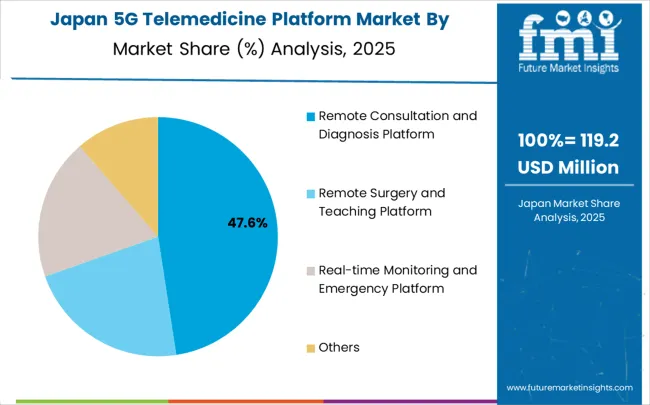
Japan is estimated to grow at a CAGR of 13.4% from 2025 to 2035, driven by demographic healthcare pressures and adoption of next-generation telemedicine platforms. Japanese healthcare facilities are implementing advanced 5G telemedicine platform systems that demonstrate superior clinical reliability and operational consistency. The market is characterized by focus on technological excellence, quality assurance, and integration with established healthcare workflows.
Healthcare technology investments are prioritizing innovative medical communication solutions that combine advanced 5G telemedicine platform technology with precision engineering while maintaining Japanese quality and reliability standards. Professional development programs are ensuring comprehensive medical expertise among healthcare personnel, enabling specialized telemedicine capabilities that support diverse medical applications and facility requirements.
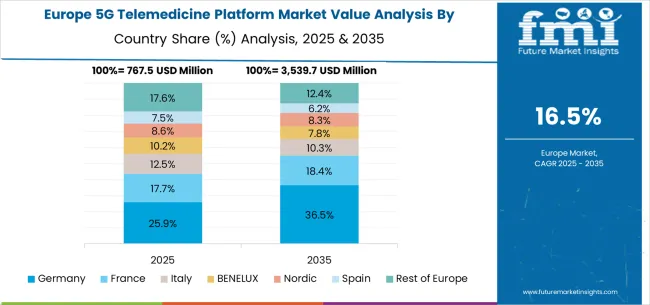
The 5G telemedicine platform market in Europe is forecast to expand from USD 917.5 million in 2025 to USD 4,763.3 million by 2035, registering a CAGR of 17.9%. Germany will remain the largest market, holding 31.8% share in 2025, easing to 31.4% by 2035, supported by strong healthcare infrastructure and advanced medical technology standards. The United Kingdom follows, rising from 23.4% in 2025 to 23.7% by 2035, driven by healthcare facility modernization and medical communication enhancement initiatives. France is expected to maintain stability from 18.2% to 17.9%, reflecting consistent healthcare investments and telemedicine requirements. Italy holds around 13.1% throughout the forecast period, supported by healthcare facility upgrades and medical infrastructure modernization programs. Spain grows from 7.8% to 8.2% with expanding healthcare infrastructure and increased focus on telemedicine solutions. BENELUX markets maintain 3.9% to 3.8%, while the remainder of Europe hovers near 1.8%--2.0%, balancing emerging Eastern European healthcare development against mature Nordic markets with established medical technology adoption patterns.
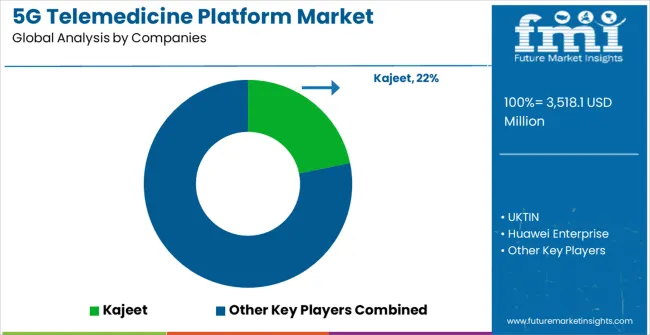
The market is defined by competition among specialized healthcare technology manufacturers, telecommunications companies, and medical communication solution providers. Companies are investing in advanced 5G technology development, platform innovation, clinical performance optimization, and comprehensive healthcare service capabilities to deliver reliable, high-performance, and cost-effective medical communication solutions. Strategic partnerships, technological innovation, and market expansion are central to strengthening product portfolios and market presence.
Kajeet offers comprehensive healthcare communication solutions with established technology expertise and professional-grade telemedicine capabilities. UKTIN provides specialized 5G infrastructure with focus on medical reliability and clinical performance. Huawei Enterprise delivers advanced healthcare platform solutions with focus on connectivity optimization and hospital-friendly operation. Siemens Healthineers specializes in medical technology with advanced healthcare integration.
JIO offers professional-grade telecommunications equipment with comprehensive healthcare support capabilities. BioSerenity delivers established medical monitoring solutions with advanced 5G technologies. GE Healthcare provides specialized medical equipment with focus on clinical optimization. T-Mobile, Enovacom, and Pixel Health offer specialized technology expertise, platform reliability, and comprehensive development across global and regional healthcare market segments.
| Item | Value |
|---|---|
| Quantitative Units | USD 3,518.1 million |
| Platform Type | Remote Consultation and Diagnosis Platform, Remote Surgery and Teaching Platform, Real-time Monitoring and Emergency Platform, Others |
| Application | In-hospital Application, Inter-hospital Collaboration, External Extension, Emergency Medical Treatment |
| Regions Covered | North America, Europe, East Asia, South Asia & Pacific, Latin America, Middle East & Africa |
| Country Covered | China, India, Germany, Brazil, United States, United Kingdom, Japan, and 40+ countries |
| Key Companies Profiled | Kajeet, UKTIN, Huawei Enterprise, Siemens Healthineers, JIO, BioSerenity, GE Healthcare, T-Mobile, Enovacom, Pixel Health |
| Additional Attributes | Dollar sales by platform type and application segment, regional demand trends across major markets, competitive landscape with established healthcare technology manufacturers and emerging telemedicine providers, customer preferences for different platform configurations and clinical options, integration with hospital systems and medical protocols, innovations in 5G medical technology and platform efficiency, and adoption of intelligent design features with enhanced connectivity capabilities for improved healthcare workflows. |
The global 5G telemedicine platform market is estimated to be valued at USD 3,518.1 million in 2025.
The market size for the 5G telemedicine platform market is projected to reach USD 18,257.4 million by 2035.
The 5G telemedicine platform market is expected to grow at a 17.9% CAGR between 2025 and 2035.
The key product types in 5G telemedicine platform market are remote consultation and diagnosis platform, remote surgery and teaching platform, real-time monitoring and emergency platform and others.
In terms of application, in-hospital application segment to command 38.0% share in the 5G telemedicine platform market in 2025.






Our Research Products

The "Full Research Suite" delivers actionable market intel, deep dives on markets or technologies, so clients act faster, cut risk, and unlock growth.

The Leaderboard benchmarks and ranks top vendors, classifying them as Established Leaders, Leading Challengers, or Disruptors & Challengers.

Locates where complements amplify value and substitutes erode it, forecasting net impact by horizon

We deliver granular, decision-grade intel: market sizing, 5-year forecasts, pricing, adoption, usage, revenue, and operational KPIs—plus competitor tracking, regulation, and value chains—across 60 countries broadly.

Spot the shifts before they hit your P&L. We track inflection points, adoption curves, pricing moves, and ecosystem plays to show where demand is heading, why it is changing, and what to do next across high-growth markets and disruptive tech

Real-time reads of user behavior. We track shifting priorities, perceptions of today’s and next-gen services, and provider experience, then pace how fast tech moves from trial to adoption, blending buyer, consumer, and channel inputs with social signals (#WhySwitch, #UX).

Partner with our analyst team to build a custom report designed around your business priorities. From analysing market trends to assessing competitors or crafting bespoke datasets, we tailor insights to your needs.
Supplier Intelligence
Discovery & Profiling
Capacity & Footprint
Performance & Risk
Compliance & Governance
Commercial Readiness
Who Supplies Whom
Scorecards & Shortlists
Playbooks & Docs
Category Intelligence
Definition & Scope
Demand & Use Cases
Cost Drivers
Market Structure
Supply Chain Map
Trade & Policy
Operating Norms
Deliverables
Buyer Intelligence
Account Basics
Spend & Scope
Procurement Model
Vendor Requirements
Terms & Policies
Entry Strategy
Pain Points & Triggers
Outputs
Pricing Analysis
Benchmarks
Trends
Should-Cost
Indexation
Landed Cost
Commercial Terms
Deliverables
Brand Analysis
Positioning & Value Prop
Share & Presence
Customer Evidence
Go-to-Market
Digital & Reputation
Compliance & Trust
KPIs & Gaps
Outputs
Full Research Suite comprises of:
Market outlook & trends analysis
Interviews & case studies
Strategic recommendations
Vendor profiles & capabilities analysis
5-year forecasts
8 regions and 60+ country-level data splits
Market segment data splits
12 months of continuous data updates
DELIVERED AS:
PDF EXCEL ONLINE
5G Electromechanical RF Switch Market Size and Share Forecast Outlook 2025 to 2035
5G Solid State Switches Market Size and Share Forecast Outlook 2025 to 2035
5G Gain Block Amplifier Market Size and Share Forecast Outlook 2025 to 2035
5G Driver Amplifier Market Size and Share Forecast Outlook 2025 to 2035
5G Millimeter Wave RF Transceiver Market Size and Share Forecast Outlook 2025 to 2035
5G Testing Market Size and Share Forecast Outlook 2025 to 2035
5G in Healthcare Market Analysis Size and Share Forecast Outlook 2025 to 2035
5G Temperature-Compensated Crystal Oscillator (TCXO) Market Size and Share Forecast Outlook 2025 to 2035
5G Remote Surgery System Market Analysis - Size, Share, and Forecast Outlook 2025 to 2035
5G Industrial IOT Market Size and Share Forecast Outlook 2025 to 2035
5G IoT Market Size and Share Forecast Outlook 2025 to 2035
5G in Defense Market Size and Share Forecast Outlook 2025 to 2035
5G Enterprise Private Network Market Size and Share Forecast Outlook 2025 to 2035
5G Edge Cloud Network and Services Market Size and Share Forecast Outlook 2025 to 2035
5G Automotive Grade Product Market Size and Share Forecast Outlook 2025 to 2035
5G Enterprise Market Size and Share Forecast Outlook 2025 to 2035
5G Infrastructure Market Size and Share Forecast Outlook 2025 to 2035
5G RAN Market Size and Share Forecast Outlook 2025 to 2035
5G Security Market Size and Share Forecast Outlook 2025 to 2035
5G Testing Equipment Market Analysis - Size, Growth, and Forecast 2025 to 2035

Thank you!
You will receive an email from our Business Development Manager. Please be sure to check your SPAM/JUNK folder too.
Chat With
MaRIA